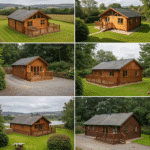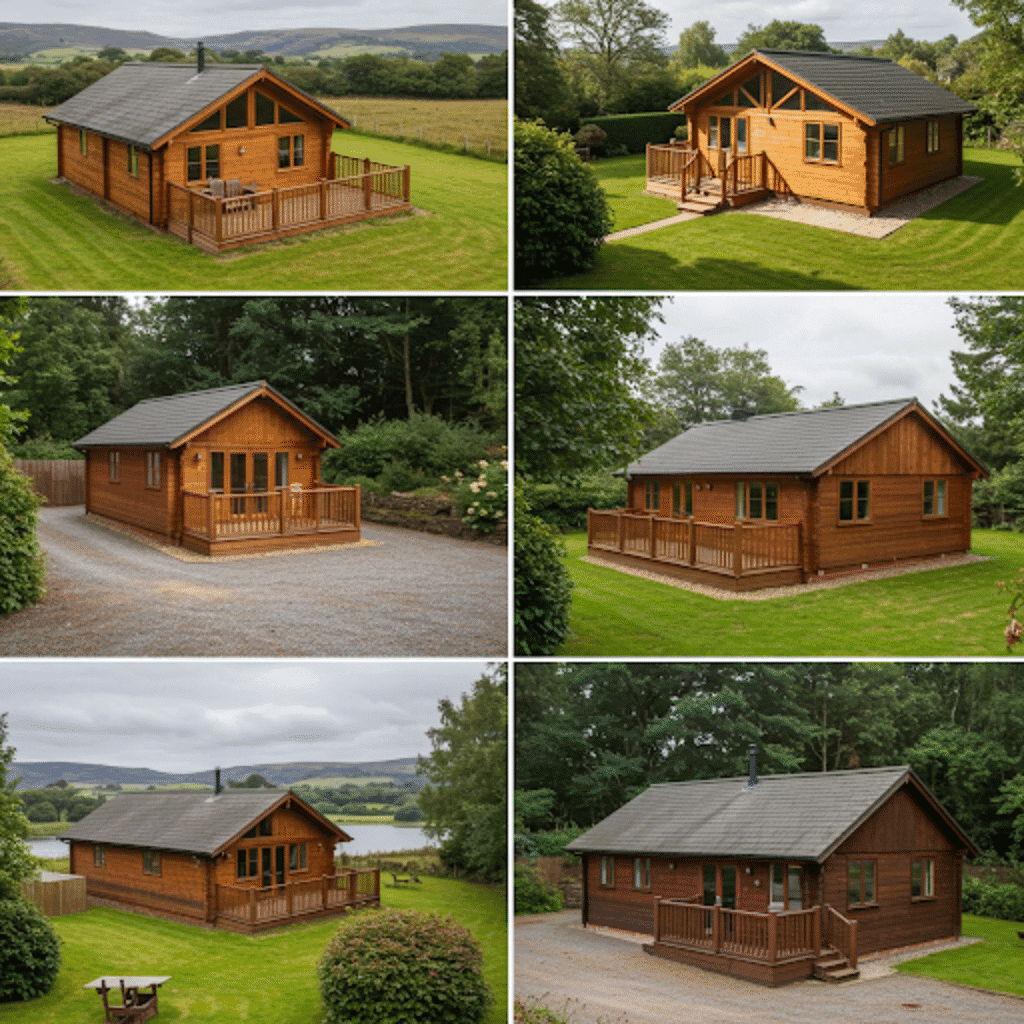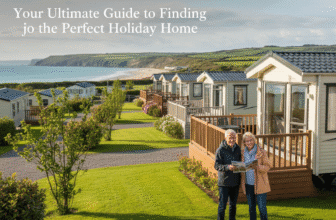
Escape to Your Own Retreat: Exploring the World of Log Cabins for Sale in the UK
There’s an undeniable charm to a log cabin. It evokes images of cosy evenings by the fire, tranquil mornings surrounded by nature, and a simpler, more grounded way of life. Whether nestled at the bottom of the garden, perched overlooking a scenic view, or serving as a primary dwelling, log cabins offer a unique blend of rustic appeal and modern functionality. In the UK, the dream of owning a log cabin is more accessible than ever, with a vast array of options available to suit diverse needs, budgets, and styles. But where do you start? This guide delves into the world of log cabins for sale, exploring the possibilities, considerations, and joys of bringing this timeless structure into your life.
Why Embrace the Log Cabin Lifestyle?
Beyond their aesthetic appeal, log cabins offer a multitude of practical and lifestyle benefits that resonate with homeowners across the UK:
- Natural Beauty and Ambience: The warm tones and textures of natural wood create an inviting and calming atmosphere that plastic or metal sheds simply can’t replicate. A log cabin becomes a feature, enhancing the beauty of its surroundings.

- Versatility Unmatched: The uses for a log cabin are limited only by your imagination. From a dedicated home office sanctuary away from household distractions to a vibrant hobby room, a fully equipped home gym, a tranquil summerhouse, overflow guest accommodation, or even a lucrative holiday let, the possibilities are endless.
- Durability and Longevity: Constructed from solid timber, well-maintained log cabins are incredibly durable and built to last for decades. The interlocking log construction provides inherent strength and stability.
- Natural Insulation: Wood is a natural insulator. Thicker logs offer better thermal performance, keeping the cabin warmer in winter and cooler in summer. This can lead to potential energy savings, especially if the cabin is used frequently or year-round.
- Eco-Friendly Potential: Timber is a renewable resource. Many suppliers source wood from sustainably managed forests. Choosing a log cabin can be a more environmentally conscious decision compared to structures made from less sustainable materials.
- Increased Property Value: A well-designed, properly installed, and maintained log cabin can be a significant asset, potentially increasing the desirability and value of your property.
- A Connection to Nature: Even when located in a suburban garden, a log cabin fosters a closer connection to the outdoors, providing a dedicated space to relax and appreciate the natural world.
Understanding the Different Types of Log Cabins
When searching for “log cabins for sale,” you’ll encounter various types and styles. Understanding the differences is key to choosing the right one for your needs:
- Construction Method:
- Interlocking Log Cabins (Kit/Prefabricated): This is the most common type available in the UK market. Precision-cut logs with notches (often tongue and groove) interlock to form the walls. They are typically supplied as kits for self-assembly or professional installation.
- Traditional Handcrafted Log Homes: These are usually larger structures, often intended as primary residences. Logs are hand-peeled and scribed to fit together. This method is more labour-intensive and significantly more expensive, often requiring specialist builders. For garden cabins, interlocking kits are the standard.
- Log Thickness: This is a crucial factor influencing insulation, durability, and potential use. Common thicknesses include:
- 19mm – 28mm: Suitable for summerhouses, storage sheds, or occasional use in milder weather. Offers minimal insulation.
- 34mm – 44mm: A popular choice for garden offices, hobby rooms, or more frequent use. Offers better insulation and rigidity. Often considered the minimum for comfortable use outside of peak summer.
- 58mm – 70mm (or thicker): Ideal for year-round use, residential cabins, holiday lets, or where superior insulation and robustness are required. Often available with options for double-glazing and additional insulation (roof/floor).
- Twin Skin/Cavity Walls: Some premium cabins feature a double wall construction with a cavity that can be filled with insulation material, offering excellent thermal performance comparable to conventional housing.
- Roof Style:
- Apex Roof: The traditional triangular roof shape, providing good headroom and effective water runoff.
- Pent Roof: A single sloping roof, often chosen for a more modern aesthetic or when height restrictions apply (e.g., close to boundaries).
- Size and Layout: Cabins range from compact 2m x 2m pods to expansive multi-room structures. Consider not just the external footprint but the internal usable space and layout (single open space, multiple rooms, veranda, canopy).
- Wood Type: Most UK log cabins are made from slow-grown Nordic Spruce or Pine. These timbers are known for their density and stability. Cedar is a premium option, known for its natural resistance to rot and insects, but comes at a higher cost.
- Bespoke vs. Standard Designs: While many standard models exist, numerous suppliers offer bespoke design services, allowing you to tailor the size, layout, window/door placement, and features to your exact requirements.
Popular Uses for Log Cabins in the UK Garden
The adaptability of log cabins makes them suitable for a huge range of purposes:
- The Garden Office Revolution: With the rise of remote and hybrid working, the demand for garden offices has soared. A log cabin provides a dedicated, professional workspace separate from the main house, minimising distractions and improving work-life balance. Consider log thickness (44mm+ recommended), insulation, double glazing, secure locks, and provision for electricity and internet connectivity.
- Summerhouses and Relaxation Retreats: Create your own garden escape for reading, relaxing, entertaining friends, or simply enjoying the view. Lighter log thicknesses (28mm+) might suffice if mainly for summer use.
- Home Gyms: Avoid gym fees and commute times by setting up a fitness space in your garden. Ensure the floor is strong enough to support equipment and consider ventilation and headroom.
- Workshops and Hobby Rooms: Whether for woodworking, crafting, painting, model railways, or music practice, a log cabin offers a dedicated space to pursue your passions without cluttering the house. Good lighting and electrical points are essential.
- Guest Accommodation: Provide comfortable, private space for visiting friends and family. Cabins with multiple rooms or ensuite facilities are ideal for this purpose. Ensure compliance with any regulations if charging for stays.
- Children’s Playhouses: A sturdy, enchanting log cabin can be the ultimate playhouse, firing imaginations and providing hours of fun. Ensure safety features are appropriate for children.
- Pool Houses or Hot Tub Enclosures: Create a stylish changing area or sheltered space for your pool or hot tub. Ensure adequate ventilation and choose materials resistant to moisture.
- Holiday Lets: A well-appointed log cabin in a desirable location can generate significant rental income. This requires careful planning regarding size, facilities, regulations, and marketing. Planning permission is almost always required.
Navigating Planning Permission and Building Regulations
This is often the biggest area of concern for potential log cabin buyers in the UK. Do you need planning permission? The answer is: it depends.
Many garden log cabins can be built under **Permitted Development Rights**, meaning you don’t need to apply for formal planning permission. However, strict rules apply:
- Location: Cabins must not be built forward of the principal elevation (the front) of the original house. Special rules apply for listed buildings, conservation areas, National Parks, and Areas of Outstanding Natural Beauty (AONBs).
- Height: Maximum eaves height of 2.5 metres and maximum overall roof height of 4 metres for an apex roof, or 3 metres for any other roof type (like a pent roof). Crucially, if the cabin is within 2 metres of a boundary, the maximum overall height is restricted to 2.5 metres.
- Size: Outbuildings (including sheds and log cabins) must not cover more than 50% of the total area of the garden (excluding the area of the original house).
- Use: Critically, permitted development rights generally only cover buildings that are ‘incidental’ to the enjoyment of the main dwelling house. This typically includes uses like garden offices (if work is primarily based elsewhere), gyms, summerhouses, and hobby rooms. Using a cabin as self-contained living accommodation (with sleeping, cooking, bathroom facilities) or as the primary place of business usually requires planning permission.
- Verandas and Platforms: Raised platforms (decking) over 30cm high may require planning permission.
When is Planning Permission Usually Required?
- If the cabin exceeds the height or size limits for permitted development.
- If it’s built forward of the principal elevation.
- If your property is a listed building or in a designated area (Conservation Area, AONB, National Park, World Heritage Site, The Broads) where permitted development rights are restricted.
- If you intend to use the cabin as self-contained living accommodation (an annexe or primary residence).
- If it will be used as a primary place of business with staff or frequent client visits.
- If your permitted development rights have been removed or restricted by a previous planning condition on your property.
Building Regulations: Separate from planning permission, Building Regulations may apply, particularly for larger cabins or those intended for sleeping accommodation. These regulations cover aspects like structural integrity, fire safety, insulation, ventilation, and electrics. Cabins under 15 square metres internal floor area, not used for sleeping, and built substantially of non-combustible materials (or located over 1 metre from any boundary) are generally exempt. Cabins between 15 and 30 square metres usually don’t require approval provided they are not used for sleeping and are at least 1 metre from any boundary or constructed of non-combustible materials. Always check the specific requirements for your intended use and size.
The Golden Rule: Always check with your local council’s planning department *before* purchasing or installing a log cabin. They can provide definitive advice based on your specific property and plans. It’s far better to be certain beforehand than to face potential enforcement action later.
Key Considerations Before You Buy
Purchasing a log cabin is a significant investment. Careful consideration of these factors will ensure you make the right choice:
- Define Your Purpose: Be absolutely clear about how you intend to use the cabin. This dictates the required size, log thickness, insulation level, layout, and features.
- Measure Your Space: Accurately measure the available space in your garden, considering not only the cabin’s footprint but also access around it for installation and maintenance, and proximity to boundaries (important for planning permission).
- Log Thickness & Insulation: Match the thickness to your intended use. For year-round comfort, 44mm+ logs with double glazing and potential roof/floor insulation are highly recommended.
- Material Quality & Treatment: Look for slow-grown, dense timber. Check if the wood is pressure-treated (for foundation bearers) or requires immediate treatment upon arrival. Understand the recommended treatment products and frequency.
- Foundation is Key: A log cabin requires a solid, level, and square foundation. Common options include a concrete slab, paving slabs on a hardcore base, or a timber frame base. An inadequate base will cause problems with assembly, door/window operation, and structural integrity. Factor base preparation into your budget and timeline.
- Windows and Doors: Check the quality of windows and doors. Are they single or double glazed? What type of locking mechanisms are used? Ensure they are appropriately weatherproofed.
- Supplier Reputation & Warranty: Research potential suppliers thoroughly. Read customer reviews, check their longevity, and understand the warranty offered on the cabin structure. Look for companies with good customer service and UK-based support.
- Installation: DIY or Professional? Log cabin kits are designed for self-assembly, but it requires significant DIY skills, time, and usually at least two people. Professional installation adds cost but ensures a correct build and saves you considerable effort. Get quotes for installation if considering this route.
- Total Budget: The kit price is just the start. Factor in:
- Delivery costs.
- Base construction costs.
- Installation costs (if not DIY).
- Wood treatment/paint.
- Electrics installation (by a qualified electrician).
- Plumbing (if required).
- Insulation (if adding).
- Guttering.
- Furnishings and interior fit-out.
- Potential planning application fees.
- Delivery Access: Log cabin kits arrive flat-packed on large pallets, often delivered by hi-ab lorries. Ensure there is adequate access to your property for the delivery vehicle and for transporting the components to the build site.
Maintaining Your Log Cabin Investment
To ensure your log cabin lasts for many years and continues to look its best, regular maintenance is essential:
- Wood Treatment: This is the most critical aspect. Untreated cabins need immediate treatment upon assembly with a high-quality wood preservative and/or topcoat (stain, paint, or oil). Re-treatment is typically required every few years, depending on the product used and exposure to the elements. Follow the manufacturer’s recommendations diligently.
- Checks and Inspections: Regularly inspect logs for any signs of splitting, rot, or insect infestation. Check seals around windows and doors. Ensure interlocking corners are sound.
- Roof Care: Keep the roof covering (felt, shingles, EPDM) in good repair to prevent leaks. Check for damage after storms.
- Gutter Cleaning: If gutters are fitted, keep them clear of leaves and debris to ensure proper drainage and prevent water overflow onto the logs.
- Ventilation: Ensure adequate ventilation, especially if the cabin is well-insulated, to prevent condensation build-up.
- Base Integrity: Periodically check that the base remains level and hasn’t subsided.
Finding Your Perfect Log Cabin
Sources for log cabins for sale in the UK include:
- Online Retailers: Numerous websites specialise in garden buildings, offering a vast range of models and price comparisons.
- Specialist Log Cabin Companies: Many companies focus solely on designing, manufacturing, and supplying log cabins, often offering bespoke services and installation.
- Garden Centres: Larger garden centres often have show models and act as agents for specific brands.
- Manufacturers Direct: Some manufacturers sell directly to the public.
- Second-Hand Market (Use Caution): While occasionally available, buying second-hand requires careful inspection. Disassembly and reassembly can be complex and may reveal hidden issues. Ensure all parts and instructions are present.
Your Dream Log Cabin Awaits
Owning a log cabin is more than just adding a structure to your garden; it’s about creating a space that enhances your lifestyle, provides a sanctuary, and brings you closer to nature. From compact garden pods to substantial multi-room buildings, the options are diverse. By carefully considering your needs, understanding the types available, navigating the planning requirements, and committing to proper maintenance, you can find the perfect log cabin for sale and turn that dream of a rustic retreat into a reality right in your own backyard. The research and planning invested now will pay dividends in years of enjoyment to come.







